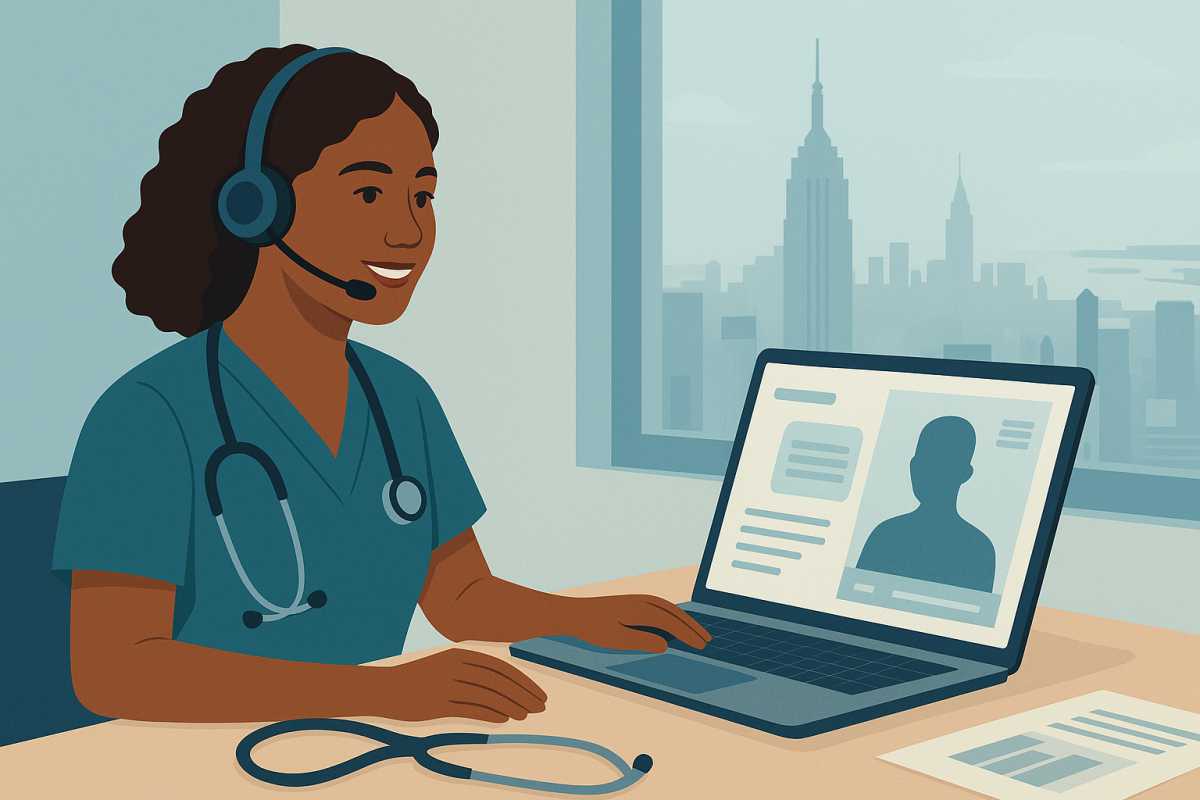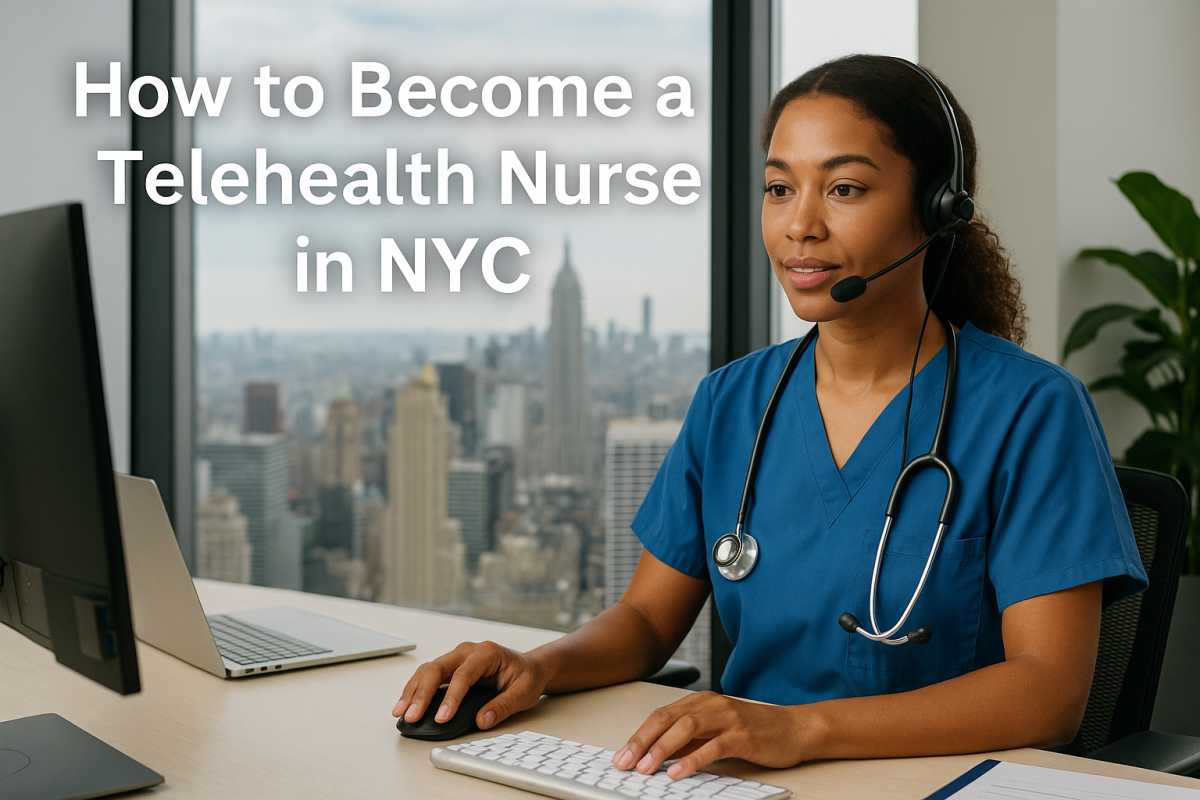Telehealth nursing is now part of everyday care in New York: hospitals run “virtual nursing” teams to support bedside units, home-care agencies triage by video, and clinics follow state telehealth rules for remote visits. If you’re a nurse exploring this path in New York City, this guide covers licensure, the Nurse Licensure Compact (NLC) status for New York, where the jobs are, the skills/tech stack you’ll need, NYC pay context, and the most reliable places to stay current.
1) Licensure in New York: What you need to practice
To work as an RN (or LPN) in New York, you must hold a New York license (or practice under a specific emergency or limited allowance, if applicable). New York’s regulator is the NYSED Office of the Professions; you can verify any New York license using the state’s official lookup tool (search by name or license number).
Quick check before interviews: run your own name through the NYSED verification page to confirm status is accurate and public-facing. (This also helps you spot any data issues early.)
What about the Nurse Licensure Compact (NLC)?
The NLC lets eligible RNs/LPNs practice across member states with one multistate license. However, New York is not an NLC member as of October 2025. NLC participation has grown nationally, but New York’s efforts remain pending/contested in the legislature; professional groups have taken differing positions on joining. Always confirm the current map and status with NCSBN, and watch New York legislative updates.
Takeaway: For NYC telehealth roles, expect employers to require a New York license by endorsement (if you’re moving from another state) or by exam (new grads). Plan your timeline accordingly.
2) Where telehealth nurses work (NYC settings)
Hospital “virtual nursing” programs: Experienced RNs support bedside teams remotely (admissions/discharges, patient education, monitoring). These models expanded post-pandemic and continue to scale. Verywell Health
Ambulatory clinics & behavioral health: Remote follow-ups, education, care coordination; programs must meet New York telehealth standards (see policy manual).
Home-care & care management: Remote triage, chronic-disease management, medication reconciliation.
Payer/case management & digital health companies: Utilization management, virtual triage, remote patient monitoring.
Most New York hospitals and health systems now offer some virtual care; national benchmarking shows near-universal adoption across systems heading into 2025. Teladoc Health
3) Practice rules you should know (NY specifics)
New York’s telehealth framework defines what counts as telehealth, which services are covered in programs like Medicaid, and documentation/privacy requirements. Get familiar with:
NYSED Telepractice Guidance (applies across licensed professions; references New York Public Health Law Article 29-G for telehealth reimbursement/authorization).
NYS Medicaid Telehealth Manual (definitions, covered services, modality rules for enrolled providers/plans). Even if you’re not billing Medicaid directly, this manual is widely referenced by employers for standards.
For behavioral-health programs, separate rules (e.g., OMH telehealth regulations) may apply at the program level. If your unit is OMH-licensed, ask how the program implements its telehealth policy and emergency protocols.
Related Article: Teletherapy in NYC
4) Skills & tech stack that hiring managers want
Triage & clinical judgment at a distance: rapid risk stratification, escalation criteria, clear documentation.
Virtual communication: teach-back, de-escalation, motivational interviewing via video/phone.
Platforms & peripherals: EHR telehealth modules, secure video, remote patient monitoring dashboards; basic troubleshooting so sessions don’t fail.
Workflow fluency in virtual nursing models: admissions/discharge support, med reconciliation, patient education handoffs to bedside teams. Evidence is growing that these programs reduce burnout and improve patient flow when implemented well.
Compliance mindset: consent scripts, identity verification, privacy (no recording unless policy allows), and scope of practice boundaries.

5) NYC pay context: what to expect
Pay varies by employer type (hospital vs. payer vs. digital health), shift differentials, union status, and whether the role is hybrid or fully remote. For broad context, the BLS reports the New York–Newark–Jersey City metro’s average (mean) hourly wage across all occupations at $40.65 (May 2024); RN-specific tables show New York metro RN wages well above national averages. Use the BLS metro tables to benchmark offers and adjust for your experience.
Tip: When comparing “remote” offers, ask whether “remote” still requires New York residence/licensure (many NYC employers do), whether out-of-state work is permitted, and how on-site days (if any) are handled.
6) Your step-by-step plan (from interest to offer)
Confirm New York eligibility
If you’re licensed elsewhere, start NY licensure by endorsement and gather verification. Then verify your license publicly via NYSED before applying; many recruiters check this first.
Get telehealth-ready
Take an employer-accepted telehealth/virtual-care course (many hospitals offer internal training). Practice consent language, emergency workflows, and video etiquette.
Target the right settings
Look for “virtual nurse,” “telehealth RN,” “RN care manager—telehealth,” “remote triage RN.” Hospital career pages and health-system networks are usually better starting points than generic job boards.(Therapy NYC)
Interview like a virtual clinician
Prepare scenario answers: unstable vitals on video, suicidal ideation during a call (and your escalation steps), equipment failure mid-visit, or handoff to bedside team.
Check compensation & schedule fit
Clarify patient assignment ratios, AHT (average handle time) for call-based roles, weekend/holiday expectations, and technology stipends.
Stay compliant
Know your documentation standards, your team’s escalation tree, and whether your employer serves Medicaid members (then the Medicaid manual’s rules will shape your day-to-day).
Note: Regulations and compact status can change. The sources above are current as of October 24, 2025; check the linked NCSBN and New York pages for updates before making licensure decisions.
